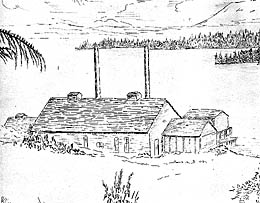In 1886, the Spring Hill Water Company builds a pumping station on Lake Washington to supply water to the city of Seattle. The company established in 1881 had drawn water from the springs and a creek along the west slope of First Hill. By 1886 the demands of a rapidly increasing population overtaxed this system. The Spring Hill Water Company decided to use Lake Washington for its water supply and constructed a pumping station on the lake at Holgate Street [1999 name]. Following is an account of Mary McWilliams who witnessed its construction. She stated:
“A road came first, cut for three miles through heavy timber, from the end of the city street at Eighth and Jackson Street to the plant at Thirty-fifth Avenue South and Holgate Street. Over this road the crews walked, the equipment and materials were hauled…. The pump station building, of wide boards, was painted a dark red in the fashion of the time. Steam power to run the Dow pump was supplied from furnaces and boilers housed in the building. … [W]ater was delivered by way of a twelve-inch force main in Holgate Street, to the reservoir at elevation 312 feet at Fourteenth Avenue South, on the top of Beacon Hill. It was this little Dow pump that … [could draw] two million gallons a day” (McWilliams, 5-6).
Coal hauled across Lake Washington supplied the energy to run the pump. The company continued to make improvements to the system and increased the water storage capacity from 200,000 gallons in 1883 to 2,500,000 gallons in 1889. But the Great Seattle Fire of June 6, 1889 proved how inadequate this system was and caused the water-company’s demise. A year later the Seattle voters approved buying the Spring Hill Water Company by a whopping 98 percent vote.

